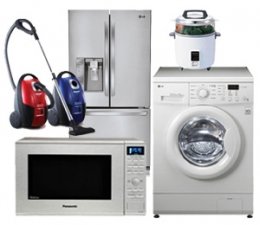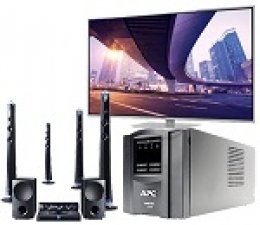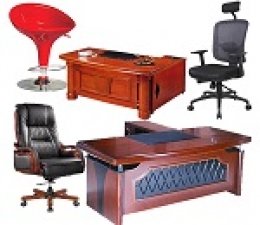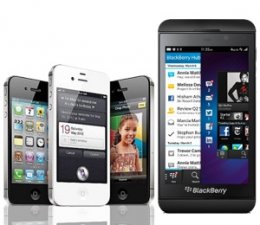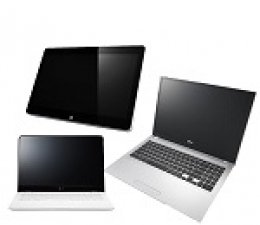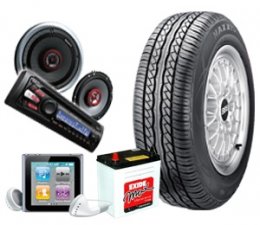A computer is a general-purpose device that can be programmed to carry out a set of arithmetic or logical operations automatically. Since a sequence of operations can be readily changed, the computer can solve more than one kind of problem.
Conventionally, a computer consists of at least one processing element, typically a central processing unit(CPU), and some form of memory. The processing element carries out arithmetic and logic operations, and a sequencing and control unit can change the order of operations in response to stored information. Peripheral devices allow information to be retrieved from an external source, and the result of operations saved and retrieved.
Mechanical analog computers started appearing in the first century and were later used in the medieval era for astronomical calculations. In World War II, mechanical analog computers were used for specialized military applications such as calculating torpedo aiming. During this time the first electronic digital computers were developed. Originally they were the size of a large room, consuming as much power as several hundred modern personal computers (PCs).
Modern computers based on integrated circuits are millions to billions of times more capable than the early machines, and occupy a fraction of the space. Computers are small enough to fit into mobile devices, and mobile computers can be powered by small batteries. Personal computers in their various forms are icons of the Information Age and are what most people consider as “computers.” However, the embedded computers found in many devices from MP3 players to fighter and from electronic toys to industrial robots are the most numerous. Devices have been used to aid computation for thousands of years, mostly using one-to-one correspondence with fingers. The earliest counting device was probably a form of tally stick. Later record keeping aids throughout the Fertile Crescent included calculi (clay spheres, cones, etc.) which represented counts of items, probably livestock or grains, sealed in hollow unbaked clay containers. The use of counting rods is one example.
The abacus was initially used for arithmetic tasks. The Roman abacus was used in Babylonia as early as 2400 BC. Since then, many other forms of reckoning boards or tables have been invented. In a medieval European counting house, a checkered cloth would be placed on a table, and markers moved around on it according to certain rules, as an aid to calculating sums of money.
The ancient Greek-designed Antikythera mechanism, dating between 150 to 100 BC, is the world's oldest analog computer. The Antikythera mechanism is believed to be the earliest mechanical analog "computer", It was designed to calculate astronomical positions. It was discovered in 1901 in the Antikythera wreck off the Greek island of Antikythera, between Kythera and Crete, and has been dated to circa 100 BC. Devices of a level of complexity comparable to that of the Antikythera mechanism would not reappear until a thousand years later.
Charles Babbage, an English mechanical engineer and polymath, originated the concept of a programmable computer. Considered the "father of the computer", he conceptualized and invented the first mechanical computer in the early 19th century. After working on his revolutionary difference engine, designed to aid in navigational calculations, in 1833 he realized that a much more general design, an Analytical Engine, was possible. The input of programs and data was to be provided to the machine via punched cards, a method being used at the time to direct mechanical looms such as the Jacquard loom. For output, the machine would have a printer, a curve plotter and a bell. The machine would also be able to punch numbers onto cards to be read in later. The Engine incorporated an arithmetic logic unit, control flow in the form of conditional branching and loops, and integrated memory, making it the first design for a general-purpose computer that could be described in modern terms as Turing-complete.
The machine was about a century ahead of its time. All the parts for his machine had to be made by hand - this was a major problem for a device with thousands of parts. Eventually, the project was dissolved with the decision of the British Government to cease funding. Babbage's failure to complete the analytical engine can be chiefly attributed to difficulties not only of politics and financing, but also to his desire to develop an increasingly sophisticated computer and to move ahead faster than anyone else could follow. Nevertheless, his son, Henry Babbage, completed a simplified version of the analytical engine's computing unit (the mill) in 1888. He gave a successful demonstration of its use in computing tables in 1906.
During the first half of the 20th century, many scientific computing needs were met by increasingly sophisticated analog computers, which used a direct mechanical or electrical model of the problem as a basis for computation. However, these were not programmable and generally lacked the versatility and accuracy of modern digital computers.
The first modern analog computer was a tide-predicting machine, invented by Sir William Thomson in 1872. The differential analyser, a mechanical analog computer designed to solve differential equations by integration using wheel-and-disc mechanisms, was conceptualized in 1876 by James Thomson, the brother of the more famous Lord Kelvin.
The art of mechanical analog computing reached its zenith with the differential analyzer, built by H. L. Hazen and Vannevar Bush at MIT starting in 1927. This built on the mechanical integrators of James Thomson and the torque amplifiers invented by H. W. Nieman. A dozen of these devices were built before their obsolescence became obvious.
By the 1950s the success of digital electronic computers had spelled the end for most analog computing machines, but analog computers remain in use in some specialized applications such as education (control systems) and aircraft (slide rule).
By 1938 the United States Navy had developed an electromechanical analog computer small enough to use aboard a submarine. This was the Torpedo Data Computer, which used trigonometry to solve the problem of firing a torpedo at a moving target. During World War II similar devices were developed in other countries as well.
Replica of Zuse's Z3, the first fully automatic, digital (electromechanical) computer. Early digital computers were electromechanical; electric switches drove mechanical relays to perform the calculation. These devices had a low operating speed and were eventually superseded by much faster all-electric computers, originally using vacuum tubes. The Z2, created by German engineer Konrad Zuse in 1939, was one of the earliest examples of an electromechanical relay computer.
In 1941, Zuse followed his earlier machine up with the Z3, the world's first working electromechanical programmable, fully automatic digital computer.[23][24] The Z3 was built with 2000 relays, implementing a 22 bit word length that operated at a clock frequency of about 5–10 Hz. Program code was supplied on punched film while data could be stored in 64 words of memory or supplied from the keyboard. It was quite similar to modern machines in some respects, pioneering numerous advances such as floating point numbers. Replacement of the hard-to-implement decimal system (used in Charles Babbage's earlier design) by the simpler binary system meant that Zuse's machines were easier to build and potentially more reliable, given the technologies available at that time.[26] The Z3 was probably a complete Turing machine.
The next great advance in computing power came with the advent of the integrated circuit. The idea of the integrated circuit was first conceived by a radar scientist working for the Royal Radar Establishment of the Ministry of Defence, Geoffrey W.A. Dummer. Dummer presented the first public description of an integrated circuit at the Symposium on Progress in Quality Electronic Components in Washington, D.C. on 7 May 1952.
The first practical ICs were invented by Jack Kilby at Texas Instruments and Robert Noyce at Fairchild Semiconductor. Kilby recorded his initial ideas concerning the integrated circuit in July 1958, successfully demonstrating the first working integrated example on 12 September 1958. In his patent application of 6 February 1959, Kilby described his new device as “a body of semiconductor material ... wherein all the components of the electronic circuit are completely integrated.” Noyce also came up with his own idea of an integrated circuit half a year later than Kilby. His chip solved many practical problems that Kilby's had not. Produced at Fairchild Semiconductor, it was made of silicon, whereas Kilby's chip was made of germanium.
This new development heralded an explosion in the commercial and personal use of computers and led to the invention of the microprocessor. While the subject of exactly which device was the first microprocessor is contentious, partly due to lack of agreement on the exact definition of the term "microprocessor", it is largely undisputed that the first single-chip microprocessor was the Intel 4004, designed and realized by Ted Hoff, Federico Faggin, and Stanley Mazor at Intel.
The defining feature of modern computers which distinguishes them from all other machines is that they can be programmed. That is to say that some type of instructions (the program) can be given to the computer, and it will process them. Modern computers based on the von Neumann architecture often have machine code in the form of an imperative programming language.
In practical terms, a computer program may be just a few instructions or extend to many millions of instructions, as do the programs for word processors and web browsers for example. A typical modern computer can execute billions of instructions per second (gigaflops) and rarely makes a mistake over many years of operation. Large computer programs consisting of several million instructions may take teams of programmers years to write, and due to the complexity of the task almost certainly contain errors.
A laptop is a personal computer that can be easily carried and used in a variety of locations. Many laptops are designed to have all of the functionality of a desktop computer, which means they can generally run the same software and open the same types of files. However, some laptops, such as netbooks, sacrifice some functionality in order to be even more portable.
Because laptops are designed for portability, there are some important differences between them and desktop computers. A laptop has an all-in-one design, with a built-in monitor, keyboard, touchpad (which replaces the mouse), and speakers. This means it is fully functional, even when there are no peripherals attached to it. A laptop is quicker to set up, and there are fewer cables to get in the way. Some newer laptops even have touch screens, so you may not even need to use a keyboard or mouse.
There also is the option of connecting a regular mouse, larger monitor, and other peripherals. This basically turns your laptop into a desktop computer, with one main difference: You can easily disconnect the peripherals and take the laptop with you wherever you go.
Here are the main differences you can expect with a laptop.
Touchpad: A touchpad—also called a trackpad—is a touch-sensitive pad that lets you control the pointer by making a drawing motion with your finger. Many touchpads now include multi-touch gestures, which allow you to perform specific tasks by making gestures with more than one finger. For example, a pinch gesture is often used to zoom in or out.
Battery: Every laptop has a battery, which allows you to use the laptop when it's not plugged in. Whenever you plug in the laptop, the battery recharges. Another benefit of having a battery is that it can provide backup power to the laptop if the power goes out.
AC adapter: A laptop usually has a specialized power cable called an AC adapter, which is designed to be used with that specific type of laptop. Some of these cables use magnetic MagSafe connectors that will safely pull out if someone trips over the power cable. This helps to prevent damage to the cable and the laptop.
Ports: Most laptops have the same types of ports desktop computers have (such as USB), although they usually have fewer ports to save space. However, some ports may be different, and you may need an adapter in order to use them. For example, the monitor port is often a Mini Display Port, which is a smaller version of the normal Display Port.
Here at Deluxe online store we have an extensive range of laptops , netbooks, iPads and other internet tablets like the Apple ipad and the Samsung Galaxy Tab on offer to ensure you find the perfect mobile computing device for your needs.
Filter by a host of criteria to find the laptop that suits your needs and budget. Amongst our range you will find laptops designed for home computing, highly portable laptops, Apple laptops and laptops that offer excellent power and performance.
If you want computing on the go, check out our range of netbooks from all the top brands including Sony, Toshiba, Advent, Acer, HP, Packard Bell and Samsung. Netbooks are perfect for lightweight mobility and fast performance but you may need the aid of an external hard drive for large storage.
Internet tablets and eReaders offer the latest in convenient mobile computing, with touchscreen technology that allows a range of activities on a computer the size of an average A4 pad. The most popular of these is the ground-breaking Apple iPad - a revolutionary computing innovation from Apple that has transformed classrooms, meeting rooms and trading posts all over the world. However, the new Samsung Galaxy Tab is fast catching up and it is easy to see why - check out the new Samsung tablet
We also have a superb selection of laptop bags and netbook cases to protect and transport your laptop.

